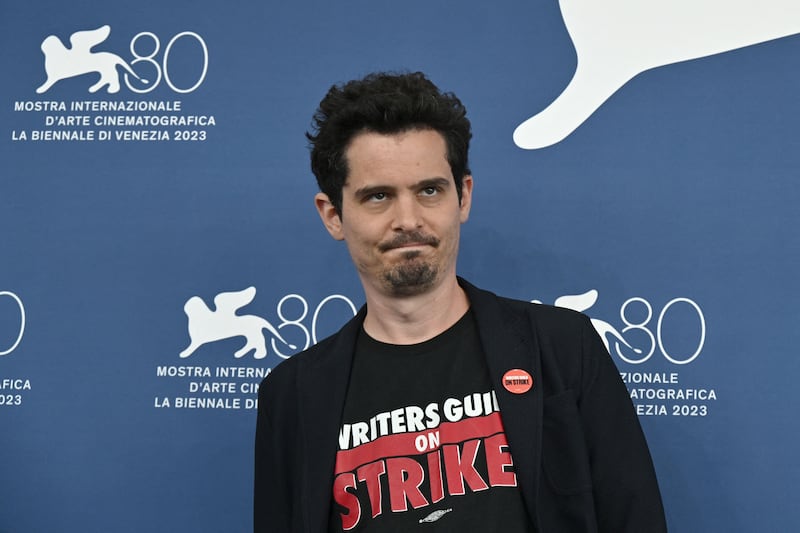To Venice International Film Festival, where, contrary to what was once suggested, we are not exactly learning about life beyond the red carpet. When it emerged that the Hollywood actors’ strike would prohibit performers from promotional duties many suspected the premieres would become celebrity-free zones.
It soon transpired that the Screen Actors Guild, the union representing actors, was happy to offer “interim agreements” to certain independent US productions. And not just teeny-tiny films about cheesemakers in rural Vermont.
Michael Mann’s Ferrari, study of the eponymous Enzo, and Sofia Coppola’s Priscilla, study of the eponymous Ms Presley, both received such agreements. Adam Driver from Ferrari is, thus, permitted to join Cailee Spaeny and Jacob Elordi from Priscilla in waving gaily before the premieres of those Venice competition titles.
Margot Robbie’s appearance in a Schiaparelli gown at the premiere of Barbie ‘generated over $2.1 million in media impact value in just 24 hours’
Indeed, the union seems positively enthusiastic about such actors attending. “Supporting productions covered by a Sag-Aftra Interim Agreement shows strong solidarity with the union,” a statement reads.
READ MORE
Here’s the question. Does such promotional hoo-ha matter? Who cares who is wearing what at which autumn festival? Life is too short to endure that TikTokticle from @Cloves_Hoarse on whose “looks” won the red carpet for Les Pamplemousses de la Mort. Right?
Well, it certainly matters to the movie stars. At the upper point of the ladder, careers swell and squeeze to the rhythms of the promotional weather. Just think back to how Elizabeth Hurley, then a jobbing actor, gained instant grade-A status by wearing a barely there Versace dress to the premiere of Four Weddings and a Funeral.
Once established, movie stars often sign contracts, sometimes worth millions, to promote the garments of high-end fashion labels. A one-off decision can offer an enormous boost to a brand. Just think how much of the preshow ballyhoo at the Oscars has to do with “who are you wearing”.
The New York Times recently reported that Margot Robbie’s appearance in a Schiaparelli gown at the premiere of Barbie “generated over $2.1 million in media impact value in just 24 hours ... more than half of what Schiaparelli’s fall 2023 show amassed overall”. When, at last year’s Venice, Timothée Chalamet turned up for the premiere of Bones and All in a Haider Ackermann halter top it did a lot for that French designer, but it also helped solidify Chalamet’s own brand identity.
You know? The quirky guy who wears avant-garde anoraks and eccentrically engineered blouses.

Red carpets matter to the festivals. There is no more convincing way of assuring your sponsors and patrons what you signify than getting photographs on the front page of the newspapers (or the online equivalent).
At Venice, the carpet, somewhat away from the main drag, stretches in reasonably civilised fashion down a parallel to the starkly modernist Palazzo del Cinema. At Cannes, arrivals are staged on the scale of a military invasion. Battalions of police and security patrol the perimeters.
Legions of photographers flock in evening dress. Pop stars, politicians and tech moguls fly in just to walk a few hundred metres of the Croisette and up the stairs to a film whose title they may have trouble naming. The tradition has been around for a century, but, in recent years, bottomless interest from endless online outlets has made the red carpet an event in itself. One can easily image a JG Ballard dystopia in which festivals were all carpet and no content.
But do they matter to the studios? As a part of the larger promotional machine – chat with Graham Norton, cover stories on Vogue, incisive pieces in The Irish Times – the red carpet does certainly contribute to awareness. Why else would the film companies meet the often considerable expense of paying for flights, make-up and accommodation in expensive locations? They’re not just giving Scarlett Johansson and Harrison Ford a free holiday.
Since the strike began, features such as Doom: Part Two, Kraven the Hunter and the tennis dramedy Challengers (originally opening this event) have been shifted from late 2023 to next year. “What the heck is Kraven the Hunter?” you say.
Well, if Aaron Taylor-Johnson and his co-stars Ariana DeBose and Russell Crowe had done a bit of waving at the premiere you might know he is a part of the Spider-Man universe. Just think how much work Margot Robbie did to help Barbie to its current hegemony.
Red-carpet culture gestures back to the spotlights and limousines of the golden age. It connects us to vanished glamour. At the top end, such events are weapons in EnormoCorp’s assault on our collective pocketbook. But, as the unions this week demonstrated, they can, now and then, also get out more radical messages.
Damien Chazelle, president of the Venice competition jury, turned up at the first press conference wearing a “Writers Guild on Strike” T-shirt. Expect more of that at premieres before this business is over.

















